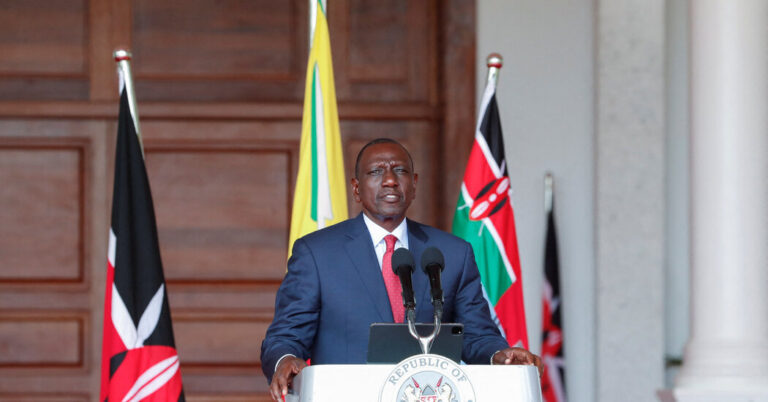President William Ruto of Kenya said on Thursday that he was dismissing his cabinet, a significant shake-up in his administration that follows weeks of youth-led antigovernment protests in which at least 41 people were killed during clashes with the police.
The protests were in opposition to a finance bill that would have raised taxes for many, but which Mr. Ruto had said was necessary to stabilize the economy of Kenya, which is deeply in debt. The president announced in a surprise move on June 26 that he would not sign the bill — a victory for the demonstrators — but protests have continued, with many demanding his resignation.
In a hotly anticipated speech at the presidential palace in the capital, Nairobi, on Thursday, Mr. Ruto defended the performance of his administration since his election in 2022, but said that the electorate expected more from his government.
“I will immediately engage in extensive consultations across different sectors and political formations and other Kenyans, both in public and private, with the aim of setting up a broad-based government,” Mr. Ruto said.
He said that after listening carefully and reviewing his cabinet’s performance, he had decided to fire the cabinet secretaries, whom he had appointed, with immediate effect including the country’s attorney general. Mr. Ruto said he would retain the foreign minister, Musalia Mudavadi, in the cabinet.
A Kenyan government website lists 24 cabinet secretaries in addition to the deputy president, Rigathi Gachagua, who Mr. Ruto said would retain his post.
The president said a new cabinet would assist him in the “implementation of radical programs to deal with the burden of debt,” eliminate wasteful government spending and “slay the dragon of corruption.”
Kenya has for decades played a leading role in the region, as well as forging close relationships with the United States and countries in the Middle East and Europe, in part because of the size of its economy and its political stability.
His decision to fire the cabinet was quickly claimed by protesters as another victory. But it was unclear whether the move would deflect criticism from the president and buy him time, or stoke the demands for further resignations — including that of the president himself.
On Thursday, the independent Kenya Human Rights Commission called on Mr. Ruto to fire more officers at the ministries and prosecute security chiefs responsible for the killings. The group also urged Mr. Ruto to nominate a smaller cabinet but gender- and ethnically-diverse cabinet.
“I feel so happy about the move that the president made,” said Daniel Mwangi, an activist in Nairobi who was among the protesters against the finance bill. “We wanted them gone.”
In the Gen Z protests, as they are known in Kenya, people flooded the streets of towns and cities around the country to denounce a finance bill that would have increased taxes on a population already struggling to afford the high cost of living. In Nairobi, some demonstrators even stormed into the Parliament building, smashed windows and set part of it on fire soon after the finance bill was passed.
The protests are unusual because they lack a centralized leadership, are not directly connected to the political opposition and have largely been organized via social media. As a result, they have presented Kenya’s security apparatus with an unusual challenge. But the extent of government force used against the demonstrators has shocked many Kenyans.
The Kenya section of the International Commission of Jurists issued a statement last week castigating what it said was the gap between the government’s professed commitment to the constitution and its actions in cracking down on the protests.
“Security forces have continued to systematically use unnecessary and excessive force against unarmed protesters, journalists, medical personnel and lawyers,” it said in a statement.
In addition to 41 deaths, 361 people have been injured and more than 670 were arbitrarily arrested, according to the Kenya National Commission on Human Rights, which was set up by Parliament.
Those detained include activists, medical workers and social media influencers who participated in the protests, some of whom said they were yanked from the street or their homes by armed men wearing balaclavas, and then blindfolded and beaten.
With the cabinet firings, regional experts said Mr. Ruto now faces a snowballing crisis and a further erosion of his government’s authority.
“The way forward would be a strong cabinet,” said Ken O. Opalo, a Kenyan political scientist at Georgetown University in Washington. “It’s hard to imagine who will convince Kenyans that this cabinet is no longer made up of members who drive flashy cars and do nothing.”



